#december 1948
Explore tagged Tumblr posts
Text


US Vogue December 1948 ❤️❤️❤️❤️❤️
Here, four reigning beauties bring to life a drawing from Charles Dana Gibson's famous series, "The Weaker Sex." Left to right: Miss Wendy Burden, Mrs. Barbara S. Paley, Mrs. Mary Sinclair/Abbott and Mrs. Philip Isles are shown as they will be dressed and wearing evening dresses designed by Mainbocher especially for the Gibson Girl Ball.
Ici, quatre beautés régnantes donnent vie à un dessin de la célèbre série de Charles Dana Gibson, « Le sexe faible ». De gauche à droite : Mlle Wendy Burden, Mme Barbara S. Paley, Mme Mary Sinclair/Abbott et Mme Philip Isles sont présentées telles qu'elles seront coiffées et portant des robes de soirée conçues par Mainbocher spécialement pour le Gibson Girl Ball.
palette.fm
Photo Horst P. Horst
vogue archive
#us vogue#december 1948#fashion 40s#fall/winter#automne/hiver#american style#mainbocher#gibson girl ball#wendy burden#babe paley#mary sinclair#mrs philip isles#horst p. horst#palette.fm
45 notes
·
View notes
Text

Gay Comics #35. December 1948
41 notes
·
View notes
Text

deadly game of cat & mouse
Rope - 1948
-
Commission for @jimmynovac
#finished this back in December but just realized I never posted it!!#sketch.art#rope 1948#alfred hitchcock#hitchcock films
86 notes
·
View notes
Photo
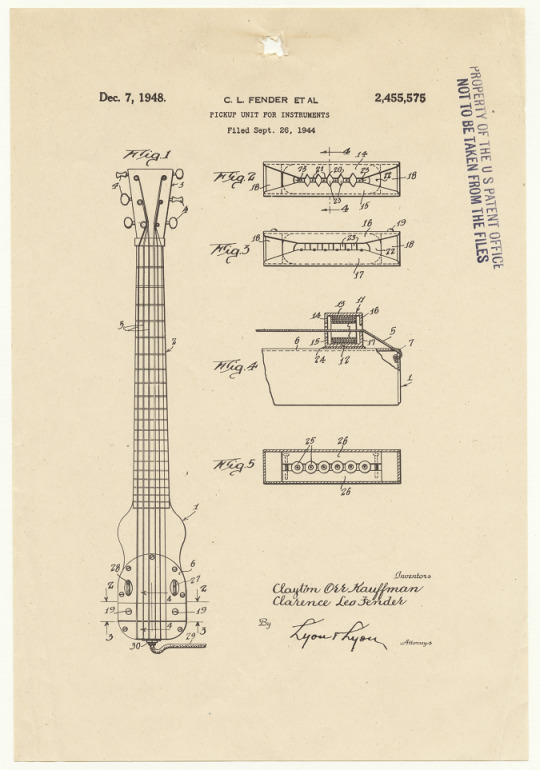
Fender and Kauffman’s Pickup Unit for Stringed Instruments, patented on 12/7/1948. The electrical pickup would eliminate sound-boxes and sounding-boards as well as produce a more natural tone.
Record Group 241: Records of the Patent and Trademark Office
Series: Selected Patent Files
Image description: Drawings and diagrams of an electrical pickup for a guitar, showing how the strings of the guitar pass through the pickup.
#archivesgov#December 7#1948#1940s#postwar#music#guitar#electric guitar#patents#patents and trademarks#Fender
124 notes
·
View notes
Text
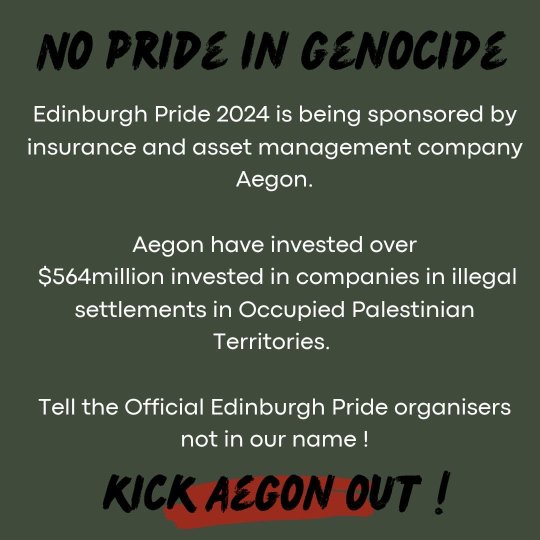
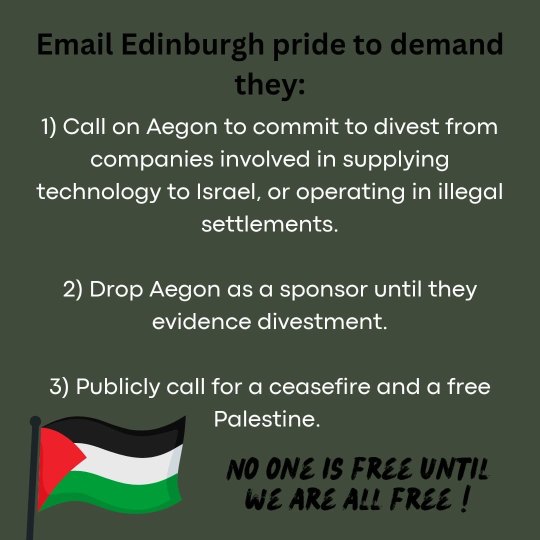
Below the cut is a template email to send to Edinburgh Pride regarding sponsorship from Aegon, who have investments linked to the genocide in Palestine. Please feel free to use this text or edit it and make it your own and send it to [email protected]
Dear Edinburgh Pride,
As a queer person living in Edinburgh, I was deeply saddened to learn that the march partner for Edinburgh Pride 2024 is Aegon.
In December 2023 the ‘Don’t Buy Into Occupation Coalition’ published a report that showed Aegon have US$564million invested via shares and bonds in companies operating in illegal settlements in Occupied Palestinian Territories. Source: https://dontbuyintooccupation.org/wp-content/uploads/2023/12/2023_DBIO-III-Report_11-December-2023.pdf
We are watching a live-streamed genocide every day - over 36,000 people in Palestine have been murdered by Israeli forces, including at least 15,000 children. The brutality of these atrocities are unthinkable, with evidence of torture and targeting of hospitals, ambulances and refugee camps.
We all have a responsibility to do what we can to end this genocide. As queer people, we are part of a rich history of resisting oppression and dehumanisation - of both ourselves and those we stand in solidarity with. Pride started as a protest against homophobia, transphobia and police violence. It is an important moment to come together as a community to celebrate queer joy and resilience.
But how can we celebrate using profits stained with the blood of our siblings in Palestine?
Aegon has $564million invested in companies that have been listed by the UN as “raising human rights concerns” for their operations in illegal settlements in Occupied Palestinian Territories, In 1948, 750,000 Palestinian people were displaced from their homes and lands and since then, Israeli settlements have been used to spread this process of colonisation.
In addition to this figure, Aegon also has major investments in Eaton Corp Plc., who supply parts for helicopters and fighter jets to the Israeli military and have recently been the target of major protests at their factory in Dorset. They also invest in Amazon, who support the Israeli military with surveillance technology used against Palestians.
Israel has long used ‘pinkwashing’ as a tactic to justify the brutal repression of Palestinians, using queer people to legitimise this horrific violence. We refuse to allow this to be done in our name.
The tide is turning on companies like Aegon that profit from investments in the companies complicit in genocide. Recently, both Hay and Edinburgh Book Festival have dropped Baillie Gifford as a sponsor after over 800 authors called on them to divest from companies involved in Israel and the fossil fuel industry.
I ask that Edinburgh Pride:
Calls on Aegon to commit to divest from companies involved in supplying technology to Israel and operating in illegal settlements.
Drop Aegon as a sponsor until they are able to show evidence of divestment.
Publicly call for a ceasefire and a free Palestine.
There is no pride in genocide.
I look forward to hearing your response.
XX
Sources:
Investments in companies operating in illegal settlements https://dontbuyintooccupation.org/wp-content/uploads/2023/12/2023_DBIO-III-Report_11-December-2023.pdf
Investments in Eaton https://extranet.secure.aegon.co.uk/static/sxhub/pdf/client-pen-distribution.pdf
Investments in Amazon https://www.aegon.co.uk/content/dam/auk/assets/publication/fund-factsheet/standard_bkj9zs0.pdf
Israel’s pinkwashing: https://bdsmovement.net/pinkwashing
War on Gaza statistics: https://www.aljazeera.com/news/longform/2023/10/9/israel-hamas-war-in-maps-and-charts-live-tracker
Edinburgh book festival ends Baillie Gifford sponsorship: https://www.bbc.co.uk/news/articles/cm553zrr3e4o
6K notes
·
View notes
Text
Germany's leading Social Democratic Party (SPD) and the opposition Christian Democratic Party (CDU) have ordered high schools in Berlin's borough of Neukolln to distribute brochures titled The Myth of Israel #1948. [...] Neukolln is one of Berlin's most diverse and international boroughs with a large Palestinian community. [...] The brochure states there are five "myths" around the creation of the state of Israel, which are subsequently refuted in short essays by various authors. In the first section, debunking myth #1, that Jews and Arabs lived together in peace before Israel was founded, Israel's pre-state militia, the Haganah, responsible for the destruction of 531 Palestinian villages and the expulsion of 700,000 Palestinians between December 1947 and the summer of 1948, is promoted as a merely "defensive" Jewish resistance movement. Under 'Myth #2: Israel was established on stolen Palestinian land', Masiyot states that the acquisition of land by Jewish immigrants to Palestine took the form of a legal exchange of capital for an official title deed. At no point in history was land illegally conquered by Jewish immigrants, the author of the text, Michael Spaney, claims. Even land conquered following the wars of 1948 and 1967 and the subsequent construction of settlements, which are internationally recognised as a violation of international law, did not occur unlawfully, it says. "Anyone who uses the accusation of land theft as an argument demonises Israel and denies its legitimacy, i.e. acts out of antisemitic motives," Spaney wrote. "Myth #5: Israel is to blame for the Nakba", includes a text by researcher Shany Mor titled "the UN is distorting the meaning of the Nakba: its view of the Israeli-Palestinian conflict is extremely one-sided". In the text, Mor states that "displacement during war - then and now - was nothing unusual". He also labels the UN's attention to the Palestinian cause "obsessive" and the Arab defeat of 1948 a myth.
. . . full article on MME (23 Feb 2024)
4K notes
·
View notes
Text
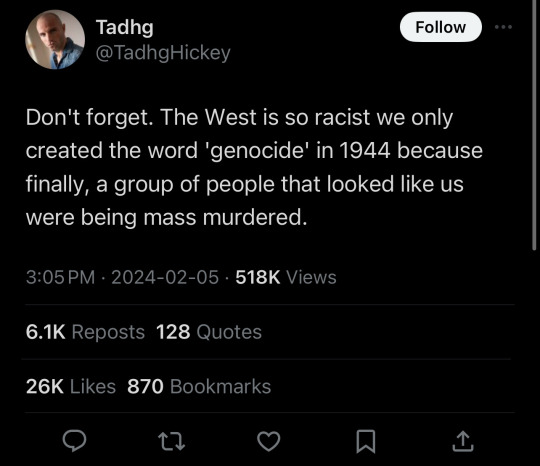
Well for one thing, you (or the West for that matter) didn’t create the word genocide, it was coined by a Polish-Jewish lawyer named Raphael Lemkin. In his book, the Axis Rule in Occupied Europe he showed his research of the way the Nazi occupied Europe and narrated how he thought the crimes the Nazi committed against the Polish during their occupation came down to 5 main policies that displayed their will to completely destroy the Polish nation which included:
1) The mass killings of Poles
2) Bringing “serious bodily or mental harm to members of the group”,
3) Planned deterioration of living conditions "calculated to bring about their destruction
4) Implementation of various "measures intended to to prevent births within the group" such as promotion of abortions, burdening pregnant women, etc.
5) Forced transfer of Polish children to German families
He used these instances as proof for the Nazi plan to completely terminate the Polish identity and these markers are still used by the Genocide Convention as proof of genocidal intentions. He also used this word to describe the atrocities that Nazi committed against the Jewish people during the Holocaust. Lemkin also spent the rest of his time advocating for an international convention to stop the rise of “future Hitlers”, and on December 9, 1948 the U.N. authorized the Genocide Convention, which had many of its clauses based on Lemkin’s own research and proposals.
Also this is a very narrow idea of racism and discrimination. Anti-semitism was rampant in American and Western society years before Hitler came into power. I mean in 1942, American literally turned away a boat load of Jewish people seeking refuge. People didn’t look at Jews and think “Oh man they look just like us, so their murders must be important and we have to create a word that describes their condition and the crimes being committed against because we care sooooo much about them”. In reality, most people didn’t really given a shit about all of the Jews being murdered, only when America and the West was being directly threatened by war did they retaliate.
So no, the West didn’t coin the word Genocide to describe the atrocities that Nazi Germany inflicted because the victims looked like them or whatever, the word was created by Polish-Jewish lawyer to describe the oppression that his people were put under.
4K notes
·
View notes
Text
poetry outlets that support a free palestine
after finding out that the poetry foundation/POETRY magazine pulled a piece that discussed anti-zionism because they "don't want to pick a side" during the current genocide, i decided to put together a list of online outlets who are explicitly in solidarity with palestine where you can read (english-language) poetry, including, except where otherwise stated, by palestinian poets!
my criteria for this is not simply that they have published palestinian poets or pro-palestine statements in the past; i only chose outlets that, since october 7, 2023, have done one of the following:
published a solidarity statement against israeli occupation & genocide
signed onto the open letter for writers against the war on gaza and/or the open letter boycotting the poetry foundation
published content that is explicitly pro-palestine or anti-zionist, including poetry that explicitly deals with israeli occupation & genocide
shared posts that are pro-palestine on their social media accounts
fyi this is undoubtedly a very small sample. also some of these sites primarily feature nonfiction or short stories, but they do all publish poetry.
outlets that focus entirely on palestinian or SWANA (southwest asia and north africa) literature
we are not numbers, a palestinian youth-led project to write about palestinian lives
arab lit, a magazine for arabic literature in translation that is run by a crowd-funded collective
sumuo, an arab magazine, platform, and community (they appear to have a forthcoming palestine special print issue edited by leena aboutaleb and zaina alsous)
mizna, a platform for contemporary SWANA (southwest asian & north africa) lit, film, and art
the markaz review, a literary arts publication and cultural institution that curates content and programs on the greater middle east and communities in diaspora
online magazines who have published special issues of all palestinian writers (and all of them publish palestinian poets in their regular issues too)
fiyah literary magazine in december 2021, edited by nadia shammas and summer farah (if you have $6 usd to spare, proceeds from the e-book go to medical aid for palestinians)
strange horizons in march 2021, edited by rasha abdulhadi
the baffler in june 2021, curated by poet/translators fady joudah & lena khalaf tuffaha
the markaz review has two palestine-specific issues, on gaza and on palestinians in israel, currently free to download
literary hub featured palestinian poets in 2018 for the anniversary of the 1948 nakba
adi magazine, who have shifted their current (october 2023) issue to be all palestinian writers
outlets that generally seem to be pro-palestine/publish pro-palestine pieces and palestinian poetry
protean magazine (here's their solidarity statement)
poetry online (offering no-fee submissions to palestinian writers)
sundog lit (offering no-fee submissions to palestinian writers through december 1, 2023)
guernica magazine (here's a twitter thread of palestinian poetry they've published) guernica ended up publishing a zionist piece so fuck them too
split this rock (here's their solidarity statement)
the margins by the asian-american writers' workshop
the offing magazine
rusted radishes
voicemail poems
jewish currents
the drift magazine
asymptote
the poetry project
ctrl + v journal
the funambulist magazine
n+1 magazine (signed onto the open letter and they have many pro-palestine articles, but i'm not sure if they have published palestinian poets specifically)
hammer & hope (signed onto the letter but they are a new magazine only on their second issue and don't appear to have published any palestinian poets yet)
if you know others, please add them on!
4K notes
·
View notes
Text

#gary thain#keef hartley band#uriah heep#god of bass#may 15 1948#december 8 1975#the new nadir#new zealand#bass
1 note
·
View note
Text

The first beauty queen in Iraq was Jewish.
In 1946, Renée Rebecca Dangoor was crowned Miss Baghdad, and she became Miss Iraq the following year, making her the first and only Jewish woman to hold these titles.
Renée was born to a Jewish Baghdadi family in December 1925. Her father, Moshe Dangoor, was the son of Ezra Dangoor, a prominent rabbi in Iraq.
Iraqi Jews are one of the oldest and most historically significant Jewish communities, tracing their roots back to the Babylonian exile in the 6th century BCE. By 1948, Iraq was home to approximately 150,000 Jews. Today, nearly all have been forced to leave the country because of their Jewish identity.
#israel#secular-jew#jewish#judaism#israeli#jerusalem#diaspora#secular jew#secularjew#islam#iraq#Bagdad#baghdad#Sephardi#Sephardic#sephardism#mizrahi#indigenous#miss iraq#beauty queen
480 notes
·
View notes
Text
The brochure states there are five "myths" around the creation of the state of Israel, which are subsequently refuted in short essays by various authors.In the first section, debunking myth #1, that Jews and Arabs lived together in peace before Israel was founded, Israel's pre-state militia, the Haganah, responsible for the destruction of 531 Palestinian villages and the expulsion of 700,000 Palestinians between December 1947 and the summer of 1948, is promoted as a merely "defensive" Jewish resistance movement. Under 'Myth #2: Israel was established on stolen Palestinian land', Masiyot states that the acquisition of land by Jewish immigrants to Palestine took the form of a legal exchange of capital for an official title deed.
At no point in history was land illegally conquered by Jewish immigrants, the author of the text, Michael Spaney, claims.Even land conquered following the wars of 1948 and 1967 and the subsequent construction of settlements, which are internationally recognised as a violation of international law, did not occur unlawfully, it says. "Anyone who uses the accusation of land theft as an argument demonises Israel and denies its legitimacy, i.e. acts out of antisemitic motives," Spaney wrote. "Myth #5: Israel is to blame for the Nakba", includes a text by researcher Shany Mor titled "the UN is distorting the meaning of the Nakba: its view of the Israeli-Palestinian conflict is extremely one-sided". In the text, Mor states that "displacement during war - then and now - was nothing unusual".He also labels the UN's attention to the Palestinian cause "obsessive" and the Arab defeat of 1948 a myth.
#yemen#jerusalem#tel aviv#current events#palestine#free palestine#gaza#free gaza#news on gaza#palestine news#news update#war news#war on gaza#germany#nakba#nakba 1948#revisionist history
1K notes
·
View notes
Text
Reminder that the Israeli government does not and never has wanted a two state solution.
Because I keep seeing the US and UK saying that this is the end goal, when it isn't.
On the 16th December 2023 Netanyahu said that he's glad he prevented the creation of a Palestinian state.
He said "You have been blaming me for almost 30 years for putting the brakes on the Oslo accords, and preventing the creation of a Palestinian state.
That is true.
I am proud that I prevented the establishment of a Palestinian state."
He says standing in occupied Palestine.
He and his government want the Palestinians to be wiped off the face of the earth and so they can take over all of Palestinian and make it Israel.
That's their plan, and it's been their plan since 1948.
#free palestine#free gaza#anti israel#anti zionisim#benjamin netanyahu#benjamin netanyahu is a war criminal#palestine#gaza
2K notes
·
View notes
Text
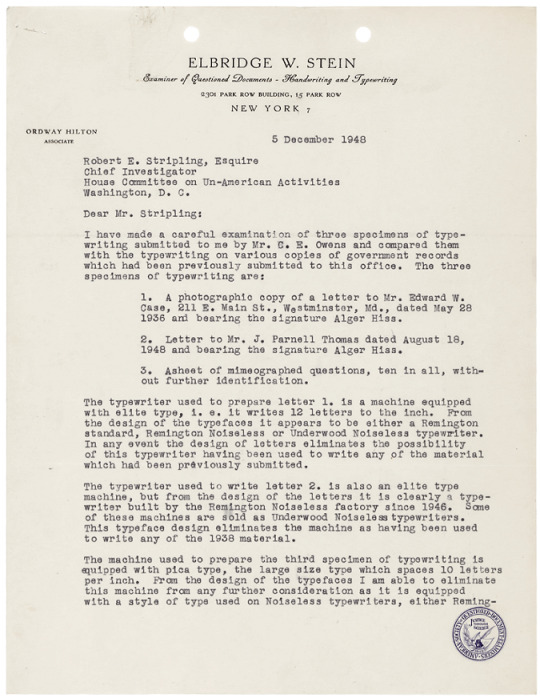
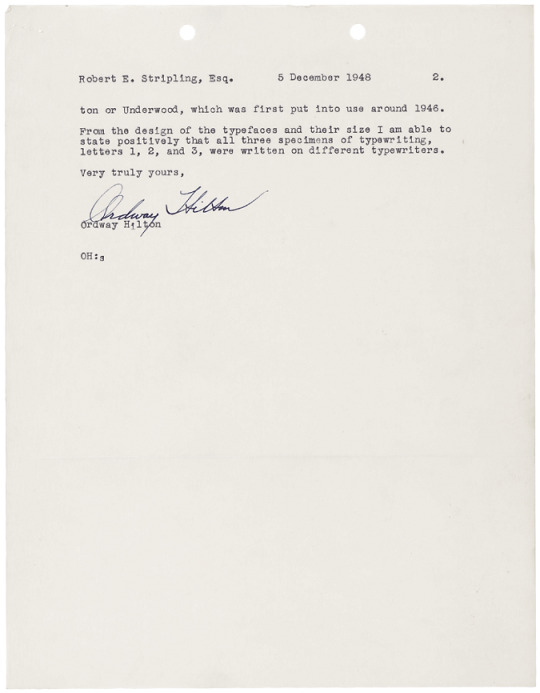
Letter from Ordway Hilton to Robert Stripling Regarding Alger Hiss
Record Group 233: Records of the U.S. House of RepresentativesSeries: Investigative Name Files
[letterhead] Elbridge W. Stein Examiner of Questioned Documents - Handwriting and Typewriting 2301 Park Row Building, 15 Park Row New York 7 5 December 1948 Robert E. Strping, Esquire Chief Investigator House Committee on Un-American Activities Washington, D.C. Dear Mr. Stripling: I have made a careful examination of three specimens of typewriting submitted to me by Mr. C.E. Owens and compared them with the typewriting on various copies of government records which had been previously submitted to this office. The three specimens of typewriting are: 1. A photographic copy of a letter to Mr. Edward W. Case, 211 E. Main St., Westminster, Md., dated May 28 1936 and bearing the signature Alger Hiss. 2. Letter to Mr. J. Parnell Thomas dated August 18, 1948 and bearing the signature Alger Hiss. 3. A sheet of mimeographed questions, ten in all, without further identification. The typewriter used to prepare letter 1. is a machine equipped with elite type, i.e. it writes 12 letters to the inch. From the design of the typefaces it appears to be either a Remington standard, Remington Noiseless or Underwood Noiseless typewriter. In any event the design of letters eliminates the possibility of this typewriter having been used to write any of the material which had been previously submitted. The typewriter used to write letter 2. is also an elite type machine, but from the design of the letters it is clearly a typewriter built by the Remington Noiseless factory since 1946. Some of these machine are sold as Underwood Noiseless typewriters. This typeface design eliminates the machine as having been used to write any of the 1938 material. The machine used to prepared the third specimen of typewriting is equipped with pica type, the large size type which spaces 10 letters per inch. From the design of the typefaces I am able to eliminate this machine from any further consideration as it is equipped with a style of type used on Noiseless typewriters, either Remington Robert E. Stripling, Esq. 5 December 1948 2. Remington or Underwood, which was first put into use around 1946. From the design of the typefaces and their size I am able to state positively that all three specimens of typewriting, letters 1, 2, and 3, were written on different typewriters. Very truly yours, [handwritten signature] Ordway Hilton [typed signature] Ordway Hilton OH:3
#archivesgov#December 30#1948#1940s#huac#house committee on unamerican activities#alger hiss#red scare#mccarthyism
10 notes
·
View notes
Text

Armenians living in the the Old City of Jerusalem are resisting against Israeli settlers who are threatening their quarter. There are an estimated 2,000 Armenians living in Jerusalem today, down from an estimated 16,000 in 1948 when the state of Israel was created. — Middle East Eye (@MiddleEastEye) December 20, 2023
847 notes
·
View notes
Text
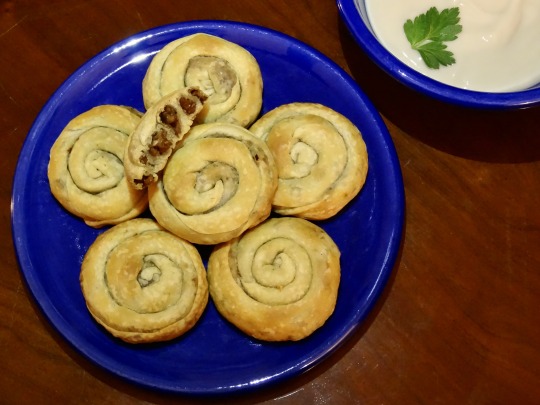
[ID: A group of pastry pinwheels on a blue plate next to a bowl of yoghurt garnished with parsley. End ID]
صفيحة يافاوية / Safiha yafawiyya (Yaffan pinwheels)
The dish
صَفِيحَة يَافَاوِيَّة ("ṣafīḥa yāfāwīyya") is a type of safiha, or flatbread, believed to have originated in the coastal city of يافا (yāfā; "Yaffa," sometimes "Jaffa"). While other versions of safiha consist of a flat piece of dough topped with meat, Yaffan safiha are made by rolling dough out to a transparent thinness, folding it to enclose a filling of meat or spinach, and then whirling it around into a pinwheel shape. More highly valued in Yaffa than flat safiha, Yaffan safiha inspires proprietary feelings amongst residents and emigrants. The technique has, however, spread to other areas in Palestine, as well as to Alexandria, Egypt, where a large number of Yaffan exiles have resettled.
Yaffan safiha may also be called "حواية" ("ḥawāya"), after a kind of towel that is stitched into a spiral and placed on top of the head to cushion it while carrying jugs of water, or trays that are hot from the oven. One Yaffan woman remembers her mother assembling these pastries at home and then bringing them, in a large copper tray, to the baker, so they could be cooked in a shared oven for a small fee. The baker's wife would have to wait to use the oven another day. The usage of communal ovens by those who do not have an oven in their home is still common practice in rural areas of Palestine.
Traditionally, the dough used to make Yaffan safiha includes only flour, salt, oil, and water. Some modern Palestinian recipes leaven the dough with baking powder; or include milk powder as a way to use food aid from NGOs, which seek to alleviate the effects of the Israeli occupation's extreme restriction of transport, travel, and agricultural activities on Palestinians' diets. With a spinach filling and without milk powder, the safa'ih may be described as "صيامي" ("ṣiyāmī): a word derived from "صِيَام" ("ṣiyām"; "fast") but which, due to the abstention from meat mandated during the Lenten fast, is colloquially used to mean "vegetarian."
Golden brown and fragrant with olive oil, these safa'ih combine layers of crisp, flaky dough with a savory, well-spiced filling. Recipes for both a 'meat' and a spinach filling are provided. A side of yoghurt and a garnish of mint round out the flavors of the filling and add tanginess and textural contrast.
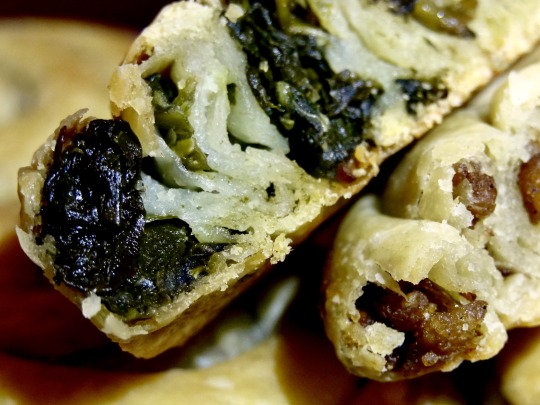
[ID: Close-up of two pinwheels cut open to reveal a spinach filling and a 'meat' filling between thin layers of pastry. End ID]
The Bride of Palestine
Yaffa is a port city with an ancient history which, until the 20th century, was the largest Arab city in, and the cultural and economic capital of, Palestine. For this reason it has sometimes been called عروس" "فلسطين ("'arūs filasṭīn"); "The Bride of Palestine." With the 1909 founding of the nearby Tel Aviv, Yaffa began to be considered its "twin" or "sister" ("האחיות") city; it had a distinctly Arab character where Tel Aviv was almost entirely Jewish. Yaffa was thus considered in disctinctly racialized terms: both attraction and threat; a source of authentic rootedness in the land which could be tapped, but also a potentially contagious bastion of Oriental "weak[ness]" ("חליש").
Yaffa had been a popular destination for culinary tourism in Mandate Palestine, with young settlers heading to the seaside to escape from religious studies and religious dietary restrictions—associated with diaspora Judaism and a lack of connection to a homeland—and to eat earthier Arab foods such as hummus, falafel, kebab, and ful.
In 1948, Zionist paramilitary organization Irgun dropped several tons of British bombs on major civilian areas of Yaffa in order to overwhelm resistance and empty the city of its Arab population; they destroyed the much of the Old City in the process. The neighborhood of المنشية (Manshiya) was destroyed shortly thereafter. Beginning in December of 1948, Yaffa was, part by part, annexed to Tel Aviv.
Today, despite the annexation and the Hebraization of the street signs, Yaffa maintains an Arab character in popular discourse. The call to prayer is heard in the streets, and the أبو العافي (Abulafia) bakery and أبو حسن (Abu Hassan) hummus restaurant and remain where they have been since the 1760s and 1970s, respectively. But increasing gentrification, rising rent prices, cafes and restaurants which cater to tourists and settlers, and the construction of Jewish-only residential projects threaten to continue the ethnic cleansing of the ancient city.
Yaffan Cuisine
Israeli occupation has tended to collapse some of the regional distinctions within Palestinian cuisine, as Palestinians are forced into exile or else crowded into Gaza and into smaller and smaller enclaves within the West Bank. Some dishes, however, still have variations that are associated with particular cities. Stuffed red carrots (محشي الجزر الأحمر; "maḥshi al-jazar al-'aḥmar"), cored and filled with rice and spiced meat, are a dish common throughout Palestine but cooked differently everywhere: in a sauce of lemon juice, pomegranate molasses, and red tahina in Gaza; in tamarind paste in Al-Quds and Ramallah; and in orange juice in the orange-rich Yaffa region. Abu Hassan restaurant serves مسبحة (msabbaha), a Yaffan classic in which chickpeas and tahina are mixed with green chili pepper, and lemon juice.
Donate to an evacuation fund
Buy an eSim for use in Gaza
Help Anera provide food in Gaza
Ingredients:
For the dough (makes 32):
500g flour (4 cups + 1 Tbsp)
1 tsp table salt
2 Tbsp olive oil
Enough water to form a soft, tacky dough (about 1 3/4 cup / 500mL)
For the meat filling (makes 16):
125g vegetarian ground beef (as a substitute for minced lamb)
1 small yellow onion, minced
1 Tbsp olive oil
1/2 tsp ground allspice
1/2 tsp ground black pepper
1/2 tsp ground cardamom
1/2 tsp table salt, or to taste
1/2 Tbsp ground sumac
1/2 Tbsp pomegranate molasses (optional)
For the spinach filling (makes 16):
500g spinach, washed and chopped
1 tsp kosher salt, for removing water
1 small yellow onion, minced
1 Tbsp olive oil
1/4 tsp ground black pepper
1/4 tsp table salt, or to taste
Squeeze of lemon juice
1 tsp shatta (hot red pepper paste)
1/2 Tbsp pomegranate molasses (optional)
Some recipes include sumac in the spinach filling, but this is not considered traditional.
Instructions:
For the dough:
1. Measure dry ingredients into a large mixing bowl. Add oil and mix briefly. Add water, a little at a time, until the dough comes together into a slightly tacky ball. Knead for five minutes, until smooth and elastic.
2. Divide dough into 16 balls of about 50g each. Roll it out into a cylinder and cut it in half repeatedly; or weigh the dough using a kitchen scale and divide by 16.
3. Pour some olive oil in a tray or baking sheet and coat each dough ball. Leave them on the tray, covered, to rest while you prepare the fillings.

For the meat filling:
1. Heat 1 Tbsp olive oil on medium-high. Add meat and fry, stirring often, until nearly cooked through.
2. Add onions, salt, and spices and fry until onion is translucent.
3. Remove from heat. Stir in sumac and pomegranate molasses. Taste and adjust. Let cool.
For the spinach filling:
1. Mix spinach with salt and let sit 10-15 minutes. Squeeze to remove excess water.
2. Heat 1 Tbsp olive oil in medium-high. Fry onion, salt, and pepper for a minute until translucent.
3. Combine all ingredients. Taste and adjust salt.
To assemble:
1. Oil a clean work surface, as well as your hands. Spread a dough ball out into a very thin, translucent circle by repeatedly patting with your fingers while pushing outwards. Be sure to push outwards from the center so that the circle does not become too thin at the edges. A few small holes are okay, since the dough will be folded and rolled in on itself.
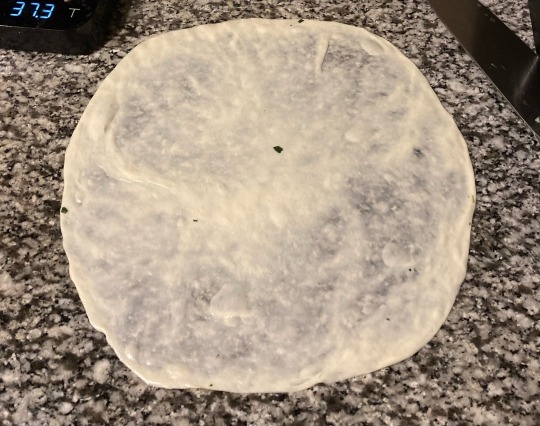
2. Cut the circle in half with a sharp knife. Spread 1/16 of either filling in a thin line along the cut edge, leaving a margin of 1 cm (1/2") or so.
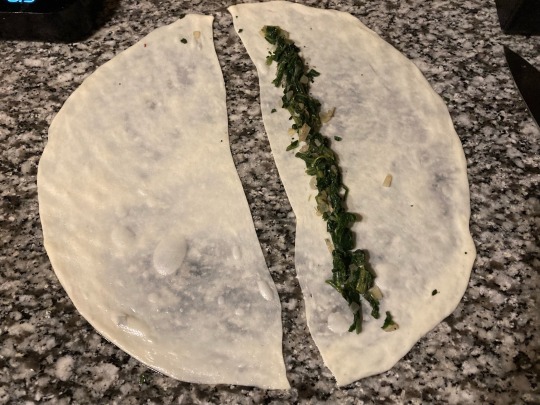
3. Roll the edge of the dough (the cut edge) over to encase the filling. Continue rolling, trying as much as possible to exclude air, until you have a long rope of dough.
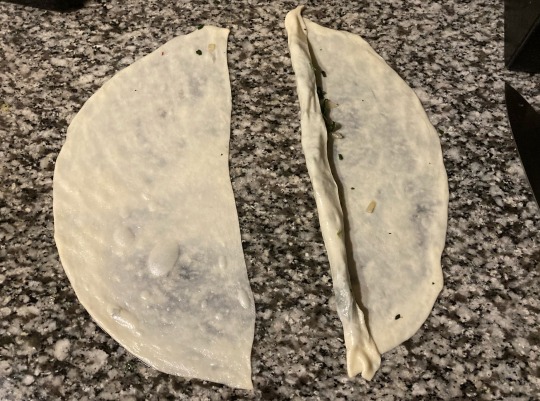
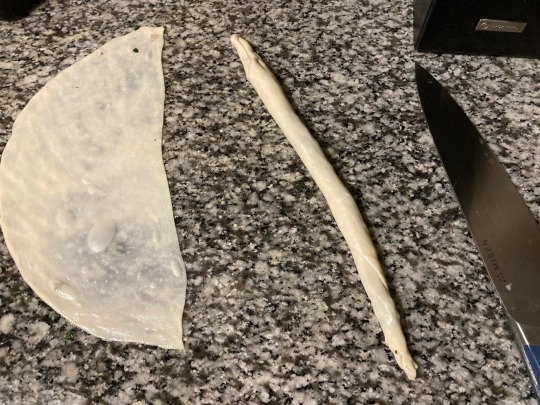
4. Roll the rope around in a tight spiral. Tuck the very end of the dough underneath and press to seal. Place on a preparing baking sheet.
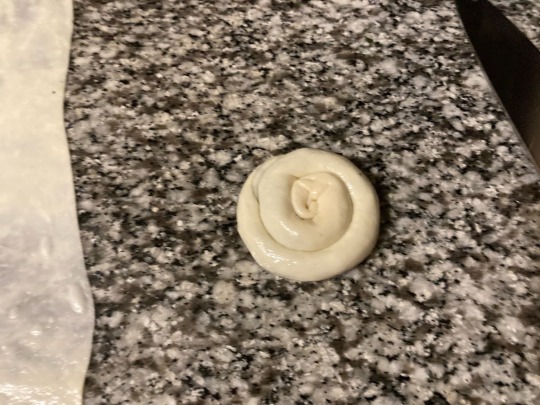
5. Repeat until the filling and dough are used up. Meanwhile, preheat an oven to 375 °F (190 °C). Bake the safiha in the top third of the oven for 25-30 minutes, or until golden in color.
Serve warm with yoghurt.
594 notes
·
View notes
Note
As much as it’s difficult to hear this, by every definition Gaza is not a genocide. That doesn’t take away how awful and horrific it is, to be sure. But it doesn’t meet the metrics necessary for that word to be used—genocide doesn’t just mean Really Really Really Bad Thing(tm), ya know? On 4/14/1994 30k Tutsi people were murdered in just one day. That’s the same # in Gaza after… 6 months. Either Israel is really bad at genocide or it’s not their intention to exterminate all the Palestinians in Gaza. Ofc genocide is more intent than #s, but by pretty much every metric… it doesn’t add up. (Also who’s saying they’re indigenous…. Like Arab colonialism anyone?)
Genocide as a definition is more than kill every member of a population, anon.
Read it:
On 11 December 1946 the General Assembly of the United Nations resolved that genocide was a crime under international law. This was approved and ratified as a Convention on the Prevention and Punishment of the Crime of Genocide on 9 December 1948. The Convention defines genocide as: ‘any of the following acts committed with intent to destroy, in whole or in part, a national, ethnical, racial or religious group, as such: -killing members of the group -causing serious bodily or mental harm to members of the group -deliberately inflicting on the group conditions of life calculated to bring about its physical destruction in whole or in part -imposing measures intended to prevent births within the group -forcibly transferring children of the group to another group
414 notes
·
View notes